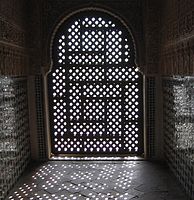Openwork

Openwork or open-work is a term in art history, architecture and related fields for any technique that produces decoration by creating holes, piercings, or gaps that go right through a solid material such as metal, wood, stone, pottery, cloth, leather, or ivory.[2] Such techniques have been very widely used in a great number of cultures.
The term is rather flexible, and used both for additive techniques that build up the design, as for example most large features in architecture, and those that take a plain material and make cuts or holes in it. Equally techniques such as casting using moulds create the whole design in a single stage, and are common in openwork. Though much openwork relies for its effect on the viewer seeing right through the object, some pieces place a different material behind the openwork as a background.
Varieties
Techniques or styles that normally use openwork include all the family of
decoration more often than not have involved openwork.In ceramics, if objects such as
There was little use of it in European ceramics before the 18th century, when designs, mostly using lattice panels, were popular in rococo ceramic "baskets", and later in English silver trays. Openwork sections can be made either by cutting into a conventional solid body before firing, or by building up using strips of clay, the latter often used when loose wickerwork is being imitated. In glass openwork is rather less common, but the spectacular Ancient Roman cage cups use it for a decorative outer layer.
Some types of objects naturally suit or even require openwork, which allows a flow of air through screens, censers or
and panels, and various parts of heating systems. For exterior screens openwork designs allow looking out, but not looking in. For gates and other types of screens, security is required, but visibility may also be wanted.
Double-openwork and triple-openwork
The terms double-openwork and triple-openwork, also called reticulated, are typically associated with ceramic pieces that are created with two or three walls. Korean ceramist Kim Se-yong produces openwork pieces.[9]
Architecture

In
Beginning with the early fourteenth-century spire at
Gallery
-
Chinese bronze axe head, Shang dynasty
-
Cast Luristan bronze openwork pinhead, Iran, circa 1000–650 BC
-
Celtic ornamental gold mounts, about 420 BC
-
BronzeScythian art, 4th century BC; a deer attacked by a wolf
-
Bronze buckle, Georgian, 1st to 4th century AD
-
Japanese canopy ritual banner, gilt-bronze, 7th century
-
Tōdai-ji, 8th century
-
Anglo-Saxon brooch from the Pentney Hoard
-
Fragrance box with openwork lid, Korea,Goryeo dynasty, 11th–12th century, bronze
-
Chinese jade ornament with vines, Jin dynasty
-
Persianincense burner, c. 11th century
-
French pyx, 1220–1240
-
Head of an Ethiopian processional cross, 13th or 14th century
-
Ivory casket, Islamic Spain or Egypt, 13th or 14th century
-
Chinese wood and lacquer screen
-
Steel plaque from Iran. One of a set of 8, probably for fixing to wood, perhaps in a royal tomb, 17th century
-
Openwork Hexagonal Ko-Kiyomizu Ware Bowl, c. 1731–1752, Japan, artist unknown, stoneware with overglaze enamels
-
American chair, 1760–80, to a design by Thomas Chippendale
-
Lotus-shaped cup with openwork handle, China, probably 19th century AD, rhinoceros horn
-
Japanesetsuba, early 19th century
-
African dancer's headpiece, wood
-
Detail of handkerchief in button-hole embroidery. Germany or Switzerland, 19th century.[12]
Architecture gallery
-
AtBorobudorhundreds of Buddha statues sit inside openwork stupas; here the nearest is partly deconstructed
-
West front ofChartres cathedral. The tower on the left is largely openwork
-
Window in the Alhambra
-
Hardwick Hall, England, 1590s
-
Brick windows on an Austrian barn
-
balustradein Germany
-
gas lamp, Vienna
-
Opernwork fasade of Prosta Tower, Warsaw
See also
References
- ^ British Museum Ref:1994,0408.29
- OED"Openwork", 1, where all examples cited from earlier than 1894 are hyphenated, though this is now less common than the single word.
- ^ Diane Favro, et al. "Rome, ancient, s 5, ii." Grove Art Online. Oxford Art Online. Oxford University Press, accessed May 27, 2015, subscription required
- ^ Department of Asian Art. "Shang and Zhou Dynasties: The Bronze Age of China". In Heilbrunn Timeline of Art History. New York: The Metropolitan Museum of Art, 2000–. (October 2004)
- ^ Timothy Taylor. "Scythian and Sarmatian art." Grove Art Online, Oxford Art Online. Oxford University Press, accessed May 27, 2015, subscription required
- ^ Tokyo National Museum (1976). 和英対照日本美術鑑賞の手引(An Aid to the Understanding of Japanese Art). pp. 132/133. (revised edition; 1964 first ed.), p.132/133
- ISBN 0-7141-1430-8, 9780714114309. Openwork bases and pedestals "became the characteristic and dominant forms in ceramics" in the Gaya confederacyperiod.
- ISBN 1101614684, 9781101614686, p. 129
- ^ Lim, Man-taek (2023-09-07). "MR O Commerce-Mirae Asset Securities hold September Finance & Art Tech Seminar Invitational! 엠알오커머스-미래에셋증권, 9월 금융 & 아트테크 세미나 초대전 개최!". 미디어피아 (in Korean). Retrieved 2024-04-21.
- ISBN 0236400363.
- ^ Robert Bork, "Into Thin Air: France, Germany, and the Invention of the Openwork Spire" The Art Bulletin 85.1 (March 2003, pp. 25–53), p 25.
- ^ The whole piece, LACMA

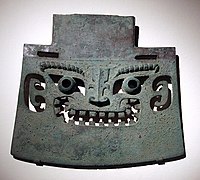

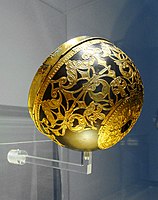


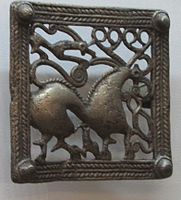





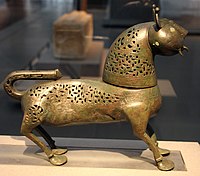
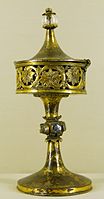

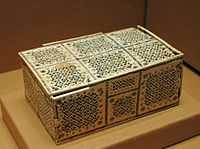
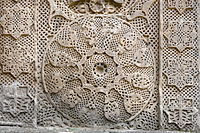
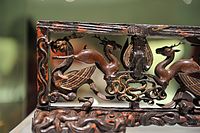



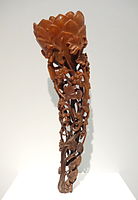

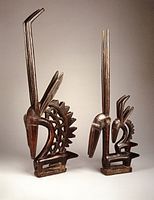
![Detail of handkerchief in button-hole embroidery. Germany or Switzerland, 19th century.[12]](http://upload.wikimedia.org/wikipedia/commons/thumb/1/13/Handkerchief%2C_embroidered_initials%2C_%27H.S.%27---in_button-_hole_embroidery._Made_in_Germany_or_Switzerland%2C_19th_century._LACMA_60.41.105_%282_of_2%29.jpg/188px-Handkerchief%2C_embroidered_initials%2C_%27H.S.%27---in_button-_hole_embroidery._Made_in_Germany_or_Switzerland%2C_19th_century._LACMA_60.41.105_%282_of_2%29.jpg)


